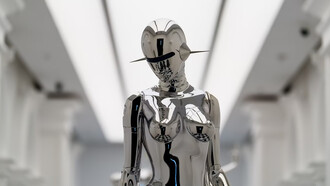Intelligence is considered "artificial" because it refers to the capability of machines or computer systems to perform tasks that typically require human intelligence. The term "artificial" distinguishes this form of intelligence from natural intelligence possessed by humans and other living beings.
It emphasizes that the intelligence displayed by machines is not innate or organic but rather created and designed by humans. Artificial intelligence (AI) relies on algorithms, data processing, and computational models to mimic human cognitive processes such as learning, problem-solving, and decision-making.
The term "artificial" highlights the man-made nature of AI systems, contrasting them with the inherent intelligence found in biological organisms.
Inherent intelligence refers to the innate cognitive abilities and intellectual capacity found in living organisms, particularly in humans and other animals. It encompasses the natural and evolved mechanisms that enable organisms to perceive, learn, reason, and adapt to their environment.
Inherent intelligence is a product of biological systems, such as the complex neural networks in the brain, which allow for various cognitive processes like memory, sensory perception, and problem-solving. It arises from the interplay of genetic factors, neural structures, and environmental interactions, shaping the unique cognitive abilities and behavioral patterns observed in different species.
Unlike artificial intelligence, inherent intelligence is an inherent and fundamental aspect of living beings. “Appreciative Intelligence is the ability to perceive the positive inherent generative potential within the present. Put in a simple way, Appreciative Intelligence is the ability to see the mighty oak in the acorn”, writes Thatchenkery and Metzker.
An analogy of AI as talking to or seeing in a mirror can be seen in the context of chatbots or conversational AI systems. Just as looking into a mirror reflects our own image back to us, AI chatbots engage in conversations with users, mirroring their input and providing responses based on pre-programmed knowledge and algorithms.
The AI chatbot acts as a virtual reflection, simulating human-like conversation and understanding. However, like a mirror, AI chatbots can only reflect what they have been trained on and lack genuine consciousness or self-awareness. They imitate human conversation, but behind the facade, it's a reflection of programmed instructions rather than true understanding.
True understanding, relative to inherent intelligence, refers to the deep comprehension and genuine cognitive grasp of concepts, information, and the world around us that arises from our inherent cognitive abilities. It involves the ability to not only process and analyze information but also to integrate it with existing knowledge, make connections, and generate new insights.
True understanding goes beyond surface-level recognition or mimicry and encompasses higher-order cognitive functions like critical thinking, reasoning, and problem-solving. It is rooted in the organic nature of inherent intelligence, which enables the synthesis of knowledge, context-dependent interpretation, and the ability to adapt and apply learned concepts in diverse situations.
In contrast, artificial intelligence, while capable of performing specific tasks and providing responses, lacks the depth of true understanding that emerges from the complex cognitive capacities of living organisms.
In Understanding False Self and True Self, Rosemary O’Toole says, “When one embarks seriously upon the spiritual journey, inevitably we discover, often through failure or a significant loss, that the conscious self is not all of me. We will find our real purpose and identity at a much deeper level than the ‘image’ we present to the world.”
GAN (Generative Adversarial Network) intelligence is a powerful approach in the field of artificial intelligence specifically designed for generating realistic and high-quality images. GANs consist of two neural networks: a generator network and a discriminator network.
The generator network generates synthetic images, while the discriminator network evaluates and distinguishes between real and fake images. Through an adversarial training process, the generator network learns to produce increasingly realistic images that can deceive the discriminator network.
GAN intelligence has revolutionized image synthesis, enabling the creation of visually appealing artwork, realistic computer graphics, and even deepfake technology. GANs have shown immense potential in various domains, including computer vision, entertainment, design, and data augmentation.
Indeed, the power of inherent and artificial intelligence lies in the ongoing and ingenious process of thinking. Inherent intelligence, rooted in biological systems, grants living beings the ability to perceive, learn, and adapt, enabling complex cognitive functions and understanding.
On the other hand, artificial intelligence, created by humans, mimics certain aspects of inherent intelligence through algorithms and computational models. It allows machines to process information, learn from data, and perform tasks that typically require human intelligence.
Both forms of intelligence continue to evolve and push the boundaries of what is possible, opening up new frontiers in technology, science, and problem-solving. The dynamic interplay between inherent and artificial intelligence drives innovation and fuels progress in our ever-expanding quest for knowledge and understanding.















